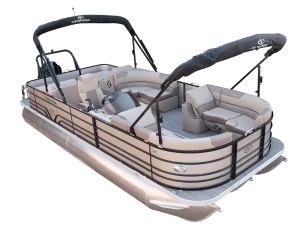Pontoons and Water Skiing: A Perfect Match
If you’re an avid water skier, you’ve probably felt the elation of exploring a new lake—hopping on the smooth-as-glass water for some afternoon fun. It’s important, however, to brush up on your skiing safety facts. Whether you’re new to water skiing or have some experience under your belt—these safety tips can help.
Tip One: The Difference Between Pontoon and Ski Boat Skiing
While getting towed by a ski boat is totally fun, a pontoon boat still has a lot to offer. To ski behind a pontoon, though, you’ll need speed. To get speed, you’ll need a pontoon capable of packing enough engine horsepower.
So, what’s the difference between pontoon and ski boat skiing? Well, to get standing on water skis, you’ll need to be moving at least 20 miles per hour. A pontoon boat tends to have a slower pickup—so make sure you’re up for some extra struggle, trying to stand. Once standing, pontoon wakes tend to have less rough water than ski boats.
This said, they aren’t as good at completing sharp maneuvers. In general, water skiing behind a ski boat will be a more side-to-side, wake-crossing experience.
Tip Two: Communicating with the Driver
It’s a good idea to lean the essential communication signals of water skiing, too. For example: Patting your head should signal that you want to get back in the boat. Creating a circle—fingers touching over your head—will signal that you’re in good condition. Raising one arm, making circles, will signal that you’re ready for another boating loop.
Double-check with your driver, and make sure you’re both brushed up on these signals—as doing so will make your outing not only safer, but more convenient. If you fall, raise one ski to signal your driver for a pickup. Your driver should always stop the boat motor when they approach a skier in the water.
Tip Three: Towing Multiple Skiers
If you’re doubling up on a skiing run, make sure both skiers have tow-lines of the same length. In fact, the tow-line length should be the same no matter how many skiers are being pulled. By keeping the lines equal length, you’ll drastically lower the risk of a skier being clothes-lined. When skiing, make sure you give yourself ample room to maneuver, too.
Tip Four: Aiming for Deep Water
As a rule of thumb, avoid shallow waters. Avoid the shoreline, in general—as well as any local swimming areas. Double-check your lake’s buoy markers before making a run—and make note of any water level changes in the area.
Tip Five: Water Safety Apparel
When skiing, wear a properly fitted, U.S. Coast Guard approved life jacket. As for your boat, there should be a highly visible orange flag. This orange flag signals to other boaters that you’re skiing. If you’ve fallen, and if you aren’t immediately visible, it’ll also signal to them to be careful driving in the area. Just make sure you’re not skiing in the dark, as doing so—on all counts—is exceedingly dangerous.
Skiing is incredibly fun, but being extra careful about your safety on the water is important. Have fun out there, and remember the tips above for a safe, stress-free ride on the water.





